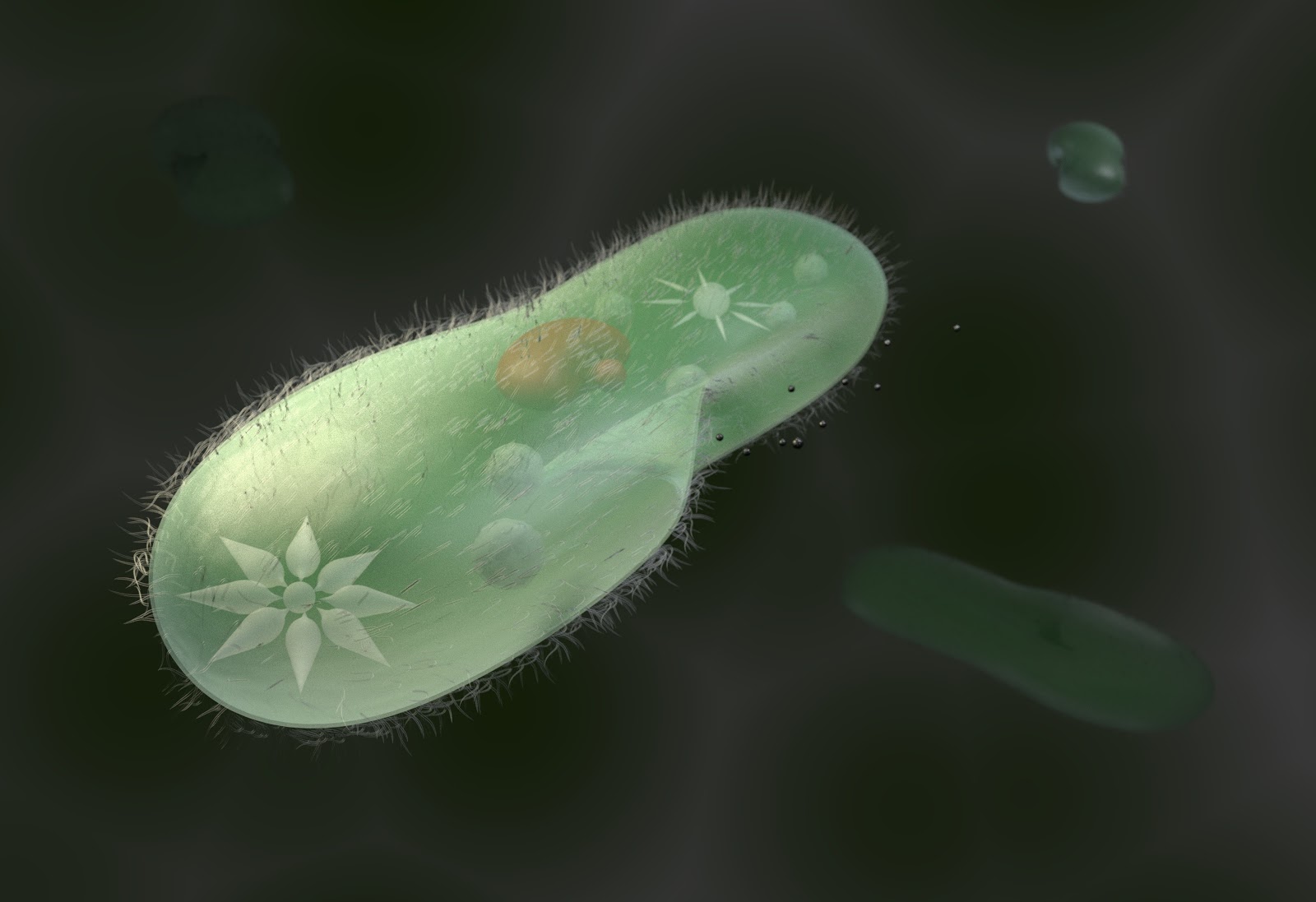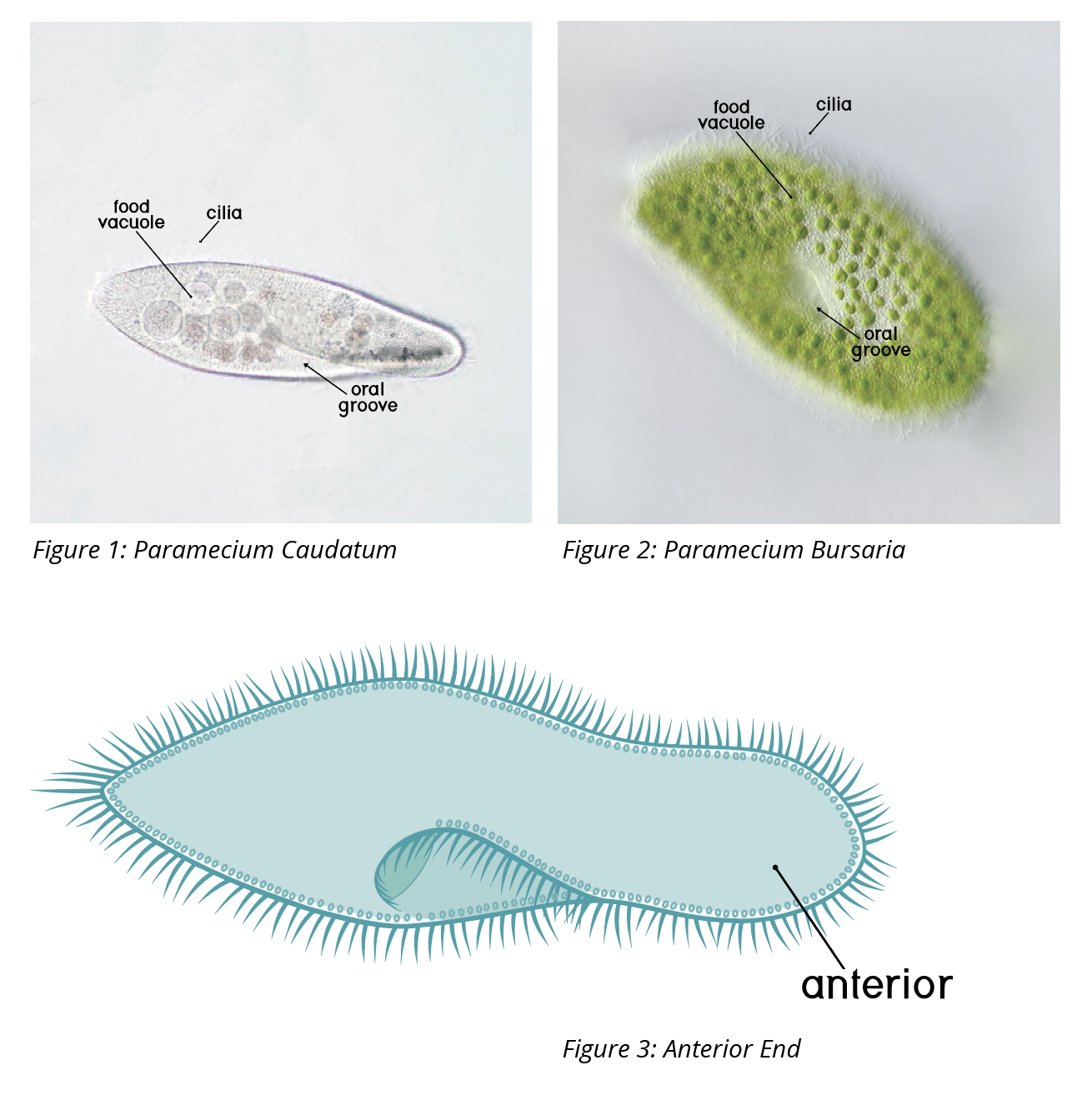Mutualism and Paramecium

AUSTRALIAN CURRICULUM ALIGNMENT
-
Relationships and interactions between species in ecosystems include predation, competition, symbiosis and disease
BACKGROUND
Paramecium are ciliated Protists that are commonly found in marine, brackish and freshwater environments. Surprisingly complex for such tiny organisms, Paramecium are currently grouped with Dinoflagellates and Sporozoans in the clade Alveolates. Like all Paramecium, Paramecium Bursaria are covered in tiny hair-like organelles called cilia. Almost half the size of Paramecium Caudatum, Paramecium Bursaria, only grows up to 0.15mm long. Paramecium Bursaria have a wide oral groove and are easily identifiable by their green colour. This green colour is the result of the mutualistic relationship between P. Bursaria and Chlorella Algae. This mutualism occurs when up to 700 Algae are swallowed by the P. Bursaria via phagocytosis. Instead of being digested, the Algae is stored within the vacuoles. They are the only known Paramecium species to form symbiotic relationships with Algae. The Algae reside within the Paramecium cytoplasm and provide nourishment in the form of Maltose; a by-product of Algal photosynthesis. In return, the Paramecium provides the Algae with protection, transport, carbon dioxide and nitrogen components. Carbohydrates are supplied to both host and symbiote when the Paramecium travels towards greater sources of light. This mutualistic symbiosis differs from obligate mutualism; whereby one organism is unable to survive without the other. Both the Algae and Paramecium are able to survive and reproduce when isolated from one another. Therefore, the relationship between the two organisms is a facultative mutualism. Despite their ability to survive independently, there is strong evidence that the two organisms benefit greatly from this mutualism. The growth of P. Bursaria carrying Algal symbionts is greater than P. Bursaria without Algae. Algae within these Paramecium hosts, also show increased rates of photosynthetic oxygen production compared to those who are isolated from their host. Furthermore, the circadian rhythms of the Paramecium and Algal photosynthesis correlate. The timing of cell division appears to be in sync.
In this investigation, students are tasked with observing these two Paramecium species under a microscope. Students identify the key features of Paramecium, observe their movement and contrast Paramecium Bursaria with Paramecium Caudatum. Students compare common Paramecium Caudatum with the mutualism of Paramecium Bursaria. This investigation is a great introduction to microscopic life forms and provides a great opportunity for students to practice sampling and wet mounting. Students gain an understanding of symbiotic associations between these cells and cell communication.
PREPARATION - BY LAB TECHNICIAN
Preparing Cultures
- As soon as your shipment arrives, open the shipping container, remove the Paramecium culture jars, and inspect your culture.
- Loosen the lids on the culture jar and aerate the culture; using a plastic pipette to bubble air into the water.
- Maintain the culture jar within room temperature (Approx. 21° C), away from direct sunlight. Plan to conduct your experiment with the Paramecium within three days of your shipment arriving. Ensure you have sufficient Paramecium for each student and take into account that some Paramecium may die.
Preparing Workstations
- Provide each student workstation with:
- Paramecium Bursaria Culture
- Paramecium Caudatum Culture
- Protoslo Solution
- 2 Microscope Slides
- 2 Plastic Pipettes
- 2 Coverslips
- 2 Toothpicks
- Stereomicroscope
METHOD - STUDENT ACTIVITY
- Collect the Paramecium cultures and take note of what you are able to observe with the naked eye.
- Remove a sample from the Paramecium Caudatum culture by compressing the bulb of the pipette between your thumb and forefinger, and lowering the tip to the bottom of the culture jar. Then, gently release the pressure on the bulb and allow the Paramecium sample to be sucked into the pipette. Remove the sample from the bottom of the jar as the Paramecium will be in the greatest concentration there.
- Deliver two to three drops of your sample onto a microscope slide along with a drop of Protoslo. Mix thoroughly with a toothpick and carefully place a coverslip over the top.
- To locate the Paramecium on the slide, observe under the low-power objective of your microscope. Centre the Paramecium in the microscopic field. Once you have located it, rotate to the high-power objective and refocus to observe the Paramecium in greater detail.
- Observe the Paramecium under the microscope and identify the cilia, cytoplasm, vacuoles, oral grove, micronucleus and other key components of Paramecia. Draw a diagram of what you see.
- Watch the swimming movement of the Paramecium for a few moments and identify if the organism has an anterior end. If so, label the anterior end.
- Follow the movement of the Paramecium swimming and note what you observe.
- Place an obstacle, such as a toothpick in front of the Paramecium on the microscope slide. Observe how the organism reacts.
- Repeat steps 2-8 for Paramecium Bursaria, using a fresh slide and pipette. Take note of any differences in the two Paramecium species, in terms of behaviour and appearance. Observe the Chlorella Algae; it will appear as green balls within the hosts cytoplasm.
OBSERVATION AND RESULTS
The main differences between Paramecium Caudatum and Paramecium Bursaria is colour. Paramecium Bursaria is green and contains Chlorella that appear as small green balls within the cytoplasm. Additionally, the shape and size of the two Paramecium is different. Paramecium Caudatum are larger and can reach 0.33 mm in length. This species is spindle-shaped; rounded at the front and tapered at the posterior to a blunt point. Paramecium Bursaria, only grows up to 0.15mm long and has a wide oral groove. Their bodies are typically shorter and wider. However, both species are covered in tiny hair-like organelles called cilia and there should be no evident behavioural difference between the two species. Both Paramecium have an anterior end that they tend to swim with. It is the more rounded end of the Paramecium. Students may observe the organisms swimming with the other end, however, this typically occurs when it comes into contact with things and is reversing. Paramecium will typically track in a slow spiral when swimming. When viewed from the rear, they rotate counter clockwise. When a they encounter an object, they will typically reverse directly backwards and then redirect to avoid the object.

INVESTIGATIONS
-
Ask students to describe the differences between the two Paramecium species.
- Challenge students to describe the mutualistic relationship between Paramecium Bursaria and Chlorella Algae.
EXTENSION EXERCISES
- A great way to see the Paramecium digestive system functioning is to feed the Paramecium a yeast/congo red solution. As the food moves is digested by the Paramecium pH changes will cause the Congo Red to change from red to blue.
- Paramecia are a ciliated protist that have previously been classified under Domain Eukarya, Kingdom Protista, and Phylum Ciliophora. Currently ciliates are often grouped with dinoflagellates and sporozoans in the clade Alveolates. The term protist, is currently used to describe a grade of organisation that includes unicellular (or multicellular without tissues) organisms; such as eukaryotic organisms. It is often referred to as the ‘junk drawer’ kingdom. To explore classification of microorganisms, you may like to discuss why the Kingdom Protista is often referred to as the ‘junk drawer’ kingdom.
- To observe how Paramecium discharge trichocysts when exposed to an acid, add a drop of vinegar to the culture on a microscope slide and place a coverslip on top.
 Time Requirements
Time Requirements
- 50 mins
 Material List
Material List
-
Paramecium Bursaria Culture
- Paramecium Caudatum Culture
- Protoslo Solution
- 2 Microscope Slides
- 2 Plastic Pipettes
- 2 Coverslips
- 2 Toothpicks
- Stereomicroscope
 Safety Requirements
Safety Requirements
-
Wear appropriate Personal Protective Equipment (PPE), including gloves and lab coat. - Paramecia are harmless to humans, but swamp or pond water may contain pathogens. Wash hands thoroughly before and after handling living specimens.
